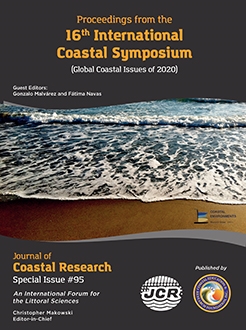Talavera, L.; del Río, L.; and Benavente, J., 2020. UAS-based high-resolution record of the response of a seminatural sandy spit to a severe storm. In: Malvárez, G. and Navas, F. (eds.), Global Coastal Issues of 2020. Journal of Coastal Research, Special Issue No. 95, pp. 679-683. Coconut Creek (Florida), ISSN 0749-0208.
Human infrastructures in barrier islands restrict the natural storm-induced overwash needed by these systems to evolve, further increasing their vulnerability in the medium and long term. For this reason, accurate overwash measurements in coastal environments subject to varying degrees of occupation are needed. In this work, two Unmanned Aerial System (UAS) flights were performed over two distinct sectors of a sandy spit located in Cádiz (SW Spain) prior and after the landfall of storm Emma. This storm was a high-energy event that lasted 153 hours,with an average significant wave height of 4 m and a storm peak of 6.81 m., and water levels (tide and surge) of up to 4 m. The images derived from the UAS flights were processed with Structure From Motion (SfM) algorithms using Pix4D software, resulting in high-resolution mosaics and Digital Elevation Models (DEMs) of the study area. These allowed (1) the digitization of the washover deposits in both sectors before and after the storm, and (2) the computation of DEMs of Difference (DoDs), which in turn allowed the analysis of volumetric estimates of erosion/accretion triggered by the significant overwash. The results revealed a nonuniform coastal response between both sectors. The area subject to higher degree of development showed a clear restriction in the onshore delivery of sediment during overwash due to the presence of a channel and a road, the coalescence of the nine pre-existing washovers into a unique deposit of 77546 m2, and much higher damage extents and associated recovery costs. In the natural sector, the overwash processes reactivated the three pre-existing washovers (which enlarged their areas up to 200%) with no significant damages reported. These findings serve as examples of coastal responses to future similar hydrodynamic conditions, and suggest that this spit will likely evolve following different trajectories in the long-term.





